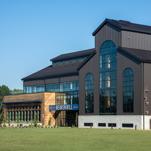National Geographic’s The Flood Is a Mind-Bending Tutorial on Ecological Connectedness
Photo: NHFU/William Steel
The treehuggers have always said it: Everything is connected. In the last hundred years, that sentiment has escaped the confines of Romantics and Transcendentalists and hippies to be embraced and vetted by physics: Everything is connected. Forms of connection once thought to be fanciful, or metaphorical, can now be duplicated, observed and vetted in labs. Eventually, and arguably “now” would be a really good interpretation of “eventually,” everyone needs to connect with the connection thing. Because once you really understand it, you cannot un-understand it, and it becomes clear that you actually do need to participate in things like not wasting resources and not putting food waste in landfills. If you want an absolutely mind-bending tutorial on connectedness, I highly recommend touching down in Botswana. And if that’s not an option, you might tune into National Geographic Channel for The Flood.
You can see the Okavango Delta from space. Both because it’s really big, and because it’s smack in the middle of the Kalahari Desert and a large network of waterways has a way of standing out against a vast backdrop of sand. It looks something like a hand, reaching into Botswana from Angola, fingers pointing southeastward. It’s a unique and intense landscape and possibly one of the world’s most unspoiled examples of How the World Works.
-

-

-

-

-

-

-

-

-

-

-

-

-

-

-

-

-

-

-

-

-

-

-

-

-

-

-

-

-

-

-

-

-

-

-

-

-

-

-

-








































